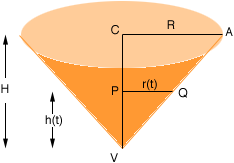| |||
| Math Central | Quandaries & Queries |
|
Question from neroshan, a student: Liquid is being poured into the top of a funnel at a steady rate of 200cm^3/s. |
Neroshan,
I drew an illustration of the funnel and called the radius R and the height H. You know that R = H.

At some time t seconds the level of the liquid in the funnel is at the line segment PQ so r(t) is the radius of the surface of the liquid at that time and h(t) is the height of the liquid. Since triangles ACV and QPV are similar r(t) = h(t). Let V(t) be the volume of liquid in the funnel at that time t so
V(t) = 1/3
r(t)2 h(t)
But r(t) = h(t) so this can be written
V(t) = 1/3
h(t)3
If you differentiate both sides with respect to t you will have an expression involving dV/dt, dh/dt and h(t). You know that dV/dt is a constant
dV/dt = 200 - 20 = 180 cm3/sec
So when h is either of the given values you can find the rate of change of the liquid height, dh/dt.
Penny
 |
||
Math Central is supported by the University of Regina and The Pacific Institute for the Mathematical Sciences.